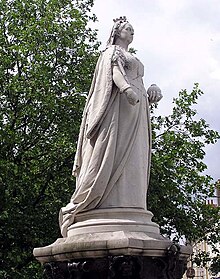Joseph Boehm

Sir Joseph Edgar Boehm, 1st Baronet , actually Böhm RA (born July 6, 1834 in Vienna , † December 12, 1890 in London ) was a medalist and sculptor . His most famous works include the face of Britain's Queen Victoria on the coin struck to mark her golden jubilee and the statue of the Duke of Wellington in Hyde Park Corner. He is one of the most important sculptors of the Victorian era .
Life
Boehm's parents were of German descent. His father Joseph Daniel Böhm was director of the engraving academy at the main mint in Vienna and also a medalist. Already as a boy he traveled with this country and received his education in Great Britain and Italy. He only worked in Vienna for a few years, mainly in the medal and coin field; In 1853 he received the Kaiserpreis for these medals and in 1856 for his sculptures. At the third world exhibition in London in 1862 his sculptures were so successful that his work with medals and coins took a back seat. His sculptures were often considered too picturesque, but were very well received at the court of Queen Victoria. His first known works include the colossal marble statue of Queen Victoria executed at Windsor Castle in 1869 and the memorial to the Queen's father, Edward Augustus, Duke of Kent and Strathearn , at St George's Chapel in Windsor.
Boehm moved to London in 1862 and took British citizenship in 1865. In 1878 he was elected a member of the ARA, the Associated Royal Academicians , the multi-year qualification before being elected full member of the British Royal Academies , where he was finally appointed in 1882.

He became particularly famous for his portrait busts, some of which can be seen today in the National Portrait Gallery in London. He often received his commissions from royal families and members of the nobility who had sculptures made for their gardens and parks. His most important works include Saint George and the Dragons , on display in front of the State Library of Victoria in Australia, and the statue of Sir Francis Drake . Many of his works can also be found in Balmoral , the summer residence of the British royal family, and in Dalmeny, Scotland . The large equestrian statue there was commissioned by Mayer de Rothschild for his newly built residence Mentmore Towers in Buckinghamshire in the 1860s .
Boehm's best-known student was Princess Louise, Duchess of Argyll , a daughter of Queen Victoria, from whom, among other things, the statue of Victoria in Kensington Gardens comes. Since Louise was also present when Boehm died in his study in South Kensington , there are still unsubstantiated rumors that the two had an affair.
Many of his statues can still be found in London today: the monument to General Charles George Gordon in Saint Paul's Cathedral , other statues can be found in Fleet Street , in Temple Bar and in the Embankment Gardens.
In 1869 Böhm modeled a self-portrait as an equestrian statuette, which was cast in bronze in the Lauchhammer art foundry.
On July 13, 1889, he was given the hereditary title of Baronet , of Wetherby Gardens, in the Parish of St. Mary Abbots, Kensington , in the County of London .
From his marriage to Louisa Frances Boteler in 1860, he had a daughter, Florence Louise Boehm, and a son, Edgar Collins Boehm, who inherited him in 1890 as 2nd baronet.
literature
- Mark Stocker: Boehm, Sir (Joseph) Edgar, baronet (1834–1890). In: Henry Colin Gray Matthew, Brian Harrison (Eds.): Oxford Dictionary of National Biography , from the earliest times to the year 2000 (ODNB). Oxford University Press, Oxford 2004, ISBN 0-19-861411-X , ( oxforddnb.com license required ), As of 2004, accessed October 22, 2007.
- Boehm, Joseph Edgar. In: Hermann Alex. Müller: Biographical Artist Lexicon. Verlag des Bibliographisches Institut, Leipzig 1882, pp. 61–62.
- Boehm, Sir Joseph Edgar . In: Encyclopædia Britannica . 11th edition. tape 4 : Bishārīn - Calgary . London 1910, p. 112 (English, full text [ Wikisource ]).
- Boehm, Josef Edgar. In: Austrian Biographical Lexicon 1815–1950 (ÖBL). Volume 1, Verlag der Österreichischen Akademie der Wissenschaften, Vienna 1957, p. 96.
Web links
- Sir Joseph Edgar Boehm, 1st Bt. On thepeerage.com
Individual evidence
- ^ L. Forrer: Boehm, Sir Joseph Edgar . In: Biographical Dictionary of Medallists . tape I . Spink & Son, London 1904, p. 204 f .
- ↑ Mark Stocker: Boehm, Sir (Joseph) Edgar, baronet (1834-1890). In: Henry Colin Gray Matthew, Brian Harrison (Eds.): Oxford Dictionary of National Biography , from the earliest times to the year 2000 (ODNB). Oxford University Press, Oxford 2004, ISBN 0-19-861411-X , ( oxforddnb.com license required ), As of 2004, accessed October 22, 2007.
- ↑ Article . In: Illustrirte Zeitung . No. 1366 . J. J. Weber, Leipzig September 4, 1869, p. 187 f., 192 (fig.).
- ↑ No. 25953, p. 3779. In: The London Gazette . July 12, 1889.
| personal data | |
|---|---|
| SURNAME | Boehm, Joseph |
| ALTERNATIVE NAMES | Böhm, Joseph Edgar; Boehm, Sir Joseph, 1st Baronet |
| BRIEF DESCRIPTION | Austro-British medalist and sculptor |
| DATE OF BIRTH | July 6, 1834 |
| PLACE OF BIRTH | Vienna |
| DATE OF DEATH | December 12, 1890 |
| Place of death | London |
